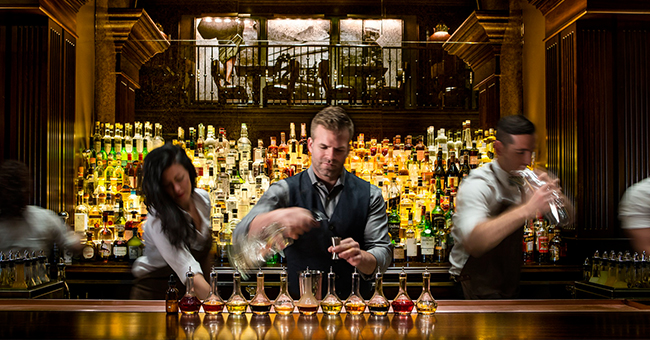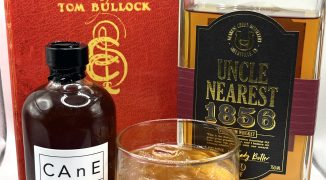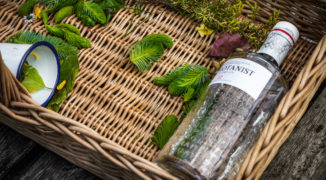When your bar team is slinging anywhere from 1,000 to 2,000 cocktails per night, remembering two dashes here and a perfectly rimmed glass there is no easy feat. Still, that quality meets quantity approach is standard for some of the nation’s leading high-volume bars, where behind-the-stick pros have tackled the best ways to deliver top notch drams to their patrons in record speed. Here, we chatted with a few of them to learn how they maintain standards on the drinks they’re putting forth — in seven minutes or less.
There’s no silver bullet to opening a killer high volume bar.
Erick Castro (Bartender and Proprietor, Polite Provisions, San Diego): “There’s not one thing that will make the bar fast. Two of the bar programs I’ve done have won Best High-Volume Bar at Tales, so everyone comes to me thinking I have some secret. But I say, ‘Look — it’s about shaving three seconds here and three seconds there, and three seconds everywhere.’”
Don’t move — not any more than you have to.
Dustin Drankiewicz (Partner and Bartender, Moneygun, Chicago): “At Moneygun we designed a really strategic bar setup, so that we can put out 30 cocktails without taking two steps in either direction to produce them. It’s about having the right sized well, having your bitters in front of you, and having your garnish, tool, and breakdown stations close by.”
Save time with consistency.
Leo Robitschek (Bar Director, The NoMad, New York City): “Muddling fruits and certain herbs is usually not the best way to incorporate flavor because, as we all know, one strawberry can differ from another — not just in size, but in sugar content and flavor. Making a syrup or infusion, though, can be a more consistent way of incorporating flavor. We use scales and a refractometer to measure sugar content and to ensure our syrups are consistent.”
Batch your spirits.
Jon McDaniel (Beverage Director, The Dawson, Chicago): “Batching is a great way you can maintain that high quality, because you’re taking a five-touch cocktail and cutting it down to one or two touches. What’s nice is that since we’re using sealed containers and keeping them in our walk-in cooler, we’re not worried about oxidation or temperature changes. When you taste the batch four or five days later, it actually tastes better than it did on day one.”
But batch them in the right way.
Leo Robitschek: “We batch a lot of spirit-based ingredients that are usually used in smaller portions within a cocktail, which helps for two reasons. It saves time because you’re only picking up one bottle instead of multiple, and the biggest margin of error is usually in the smallest measurements of ingredients. More people make mistakes in that quarter-ounce pour than they would in that half-ounce pour. If you go slightly over or under a three-quarter-ounce pour, it’s probably not going to affect the drink as much as when you go over or under a quarter-ounce pour because generally, the smaller the pour, the more flavor impact it has. It’s a lot more efficient to combine the right ratios and have a one-ounce pour instead of four quarter-ounce ones.
Jon McDaniel: “Ingredients with slightly higher sugar profiles actually do better together because they help maintain the quality and consistency of the drink itself.”
Create a workplace of accountability.
Erick Castro: “If you’re the type of bartender who likes to pick up a bottle of Cognac for a cocktail and then put it down in a completely different place, you will not fit into this environment. Everyone needs to be subscribed to the same philosophy, and working fast does not equal working efficiently.”
Keep your product around a while — but not too long.
Jon McDaniel: “Oxygen is your enemy, so the container you’re using to store your batches in is important. We’re using jugs with spouts on them, so we’re controlling the oxygen in the vessel as we fill the bottles. We want minimum oxygen because it’s oxygen that will cause your components in the batch to change.”
Dustin Drankiewicz: “We can’t be scared to throw away ingredients because if we’re producing high-quality drinks, we have to have fresh produce to use. If we’re throwing away a dollar or two of garnishes here and there, it’s no skin off our backs.”
Talk while you rock.
Erick Castro: “We have this expression behind the bar that goes “talk while you rock.” You can talk as much as you want, as long as your hands and feet are moving. Our guys are also trained to introduce patrons to other guests with similar interests. If you had a party at your house and two people walked in the door who didn’t know each other, you’d introduce them — that’s what a good host does.”
If you do slip up, make it up to them.
Leo Robitschek: “We want all of our cocktails out in seven minutes or under. If they’re not, then we’ll comp the round for the table. First and foremost we want everyone to have a cocktail in a timely manner, but also, if you’re sitting down for dinner you want to have that cocktail on your table before your appetizer.”





